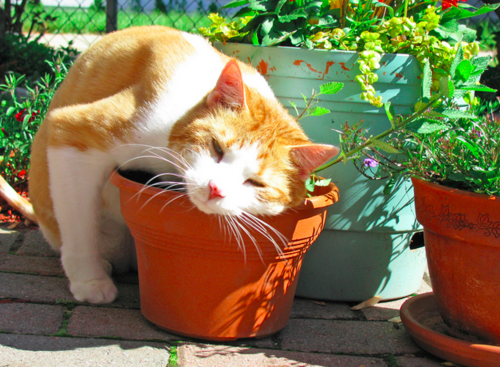
Catnip (Nepeta cataria), also known as catnep or catmint, is a hardy perennial herb. It is much loved by cats, acting as a type of "drug" for cats.
It is a perennial, as long as you keep the cats away from it, as they'll tend to chew it down. If it's vigorous, it'll usually cope with this and grow back.
Description[edit | edit source]
Catnip has soft leaves with a downy cover. They are a grey-green colour. The edges of the leaves are serrated. The leaves are highly attractive to cats.
The flowers are white to purple, and occur on spikes. The bees like the flowers.
Growing catnip[edit | edit source]
Choose soils which drain well, situated in the sun.
Provide catnip with partial shade to grow correctly. Catnip is a zone 3 to 4 plant so is hardy for temperature from -29ºC to -40ºC (-20ºF to -40ºF) so you can grow it so long as you get spring.
Sow in a seed tray in early spring, about 6mm (1/4 inch) deep. Transplant to small containers, then to the garden bed when strong enough.
Catnip can be propagated from cuttings of the young shoots during spring.
Uses for catnip[edit | edit source]
Parts used: Dried aerial parts Constituents: Volatile oil (comprising carvacrol, nepatol, thymol, nepatalactone, citronellol, geraniol); tannins.
Medical: Colds, flu, and children's illnesses. It calms the nervous system and will help put a fidgeting child to sleep.[verification needed] It also calms the stomach, countering colic, flatulence, and diarrhoea, and also known to be effective for helping with motion sickness.[verification needed] It has been used in North America to cleanse and heal the lower bowel.[verification needed]
How to prepare: Catnip is best used in an infusion. To make the tea, pour hot water over the leaves and let steep to desired strength then strain leaves.
Catnip and cats[edit | edit source]

Cats enjoy all parts of the plant and they enjoy the plant both fresh and dried.
A cat enjoying playing with catnip-stuffed toys tend to go through a variety of "stages" of reactions, consisting of: 1. Sniffing; 2. licking, chewing and head shaking; 3. cheek and chin rubbing; 4. head over rolling, body rubbing and drooling. Some of the catnip often gets eaten when the toy is broken open.